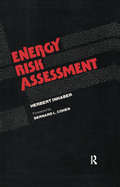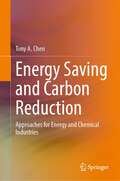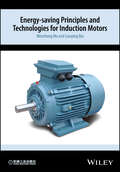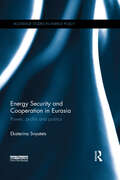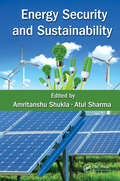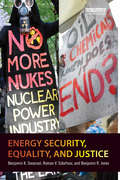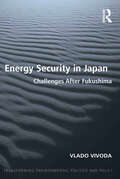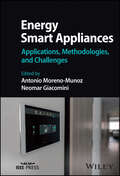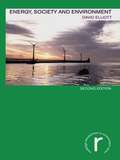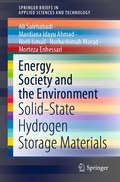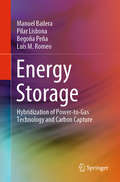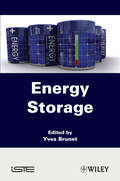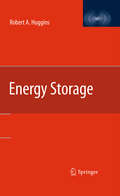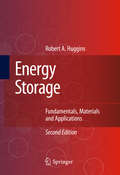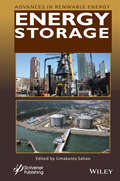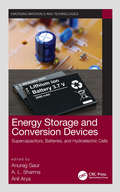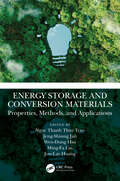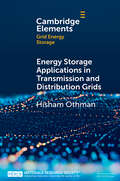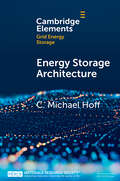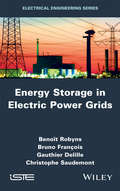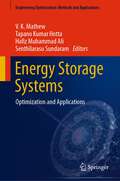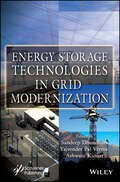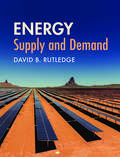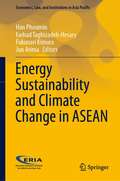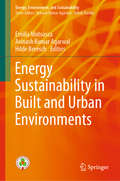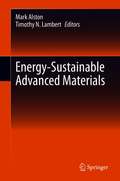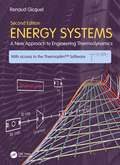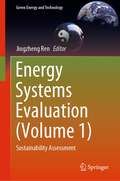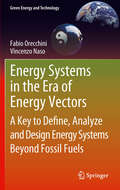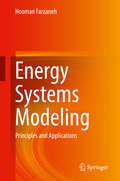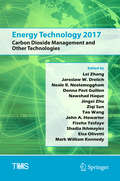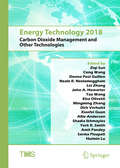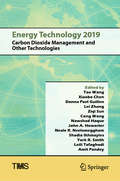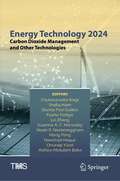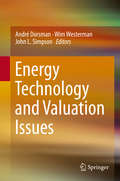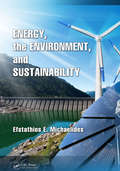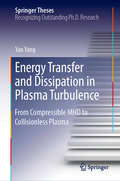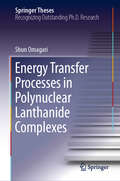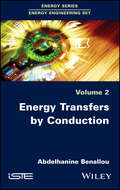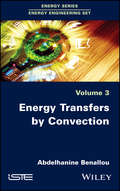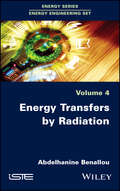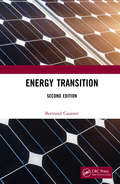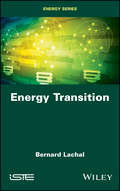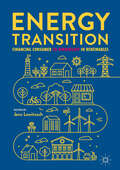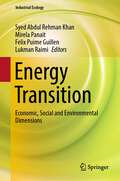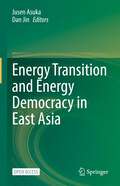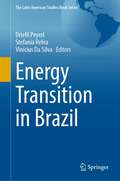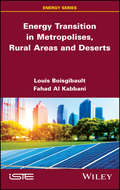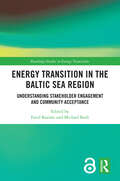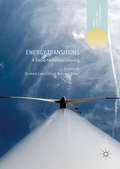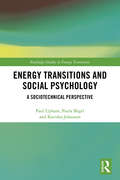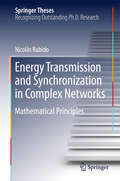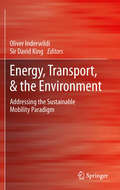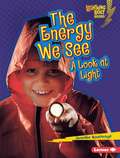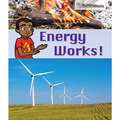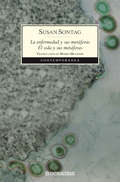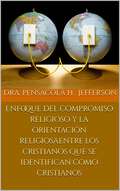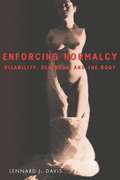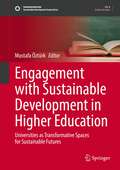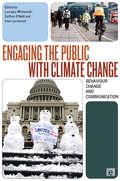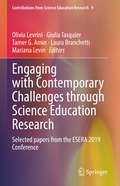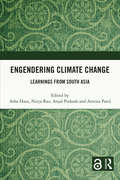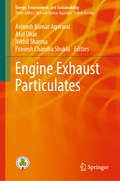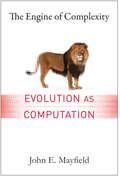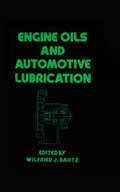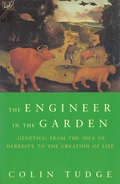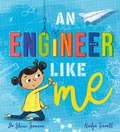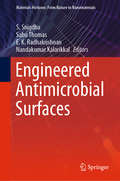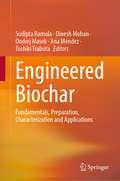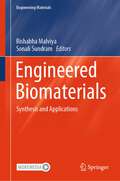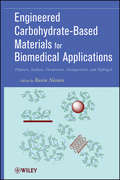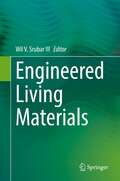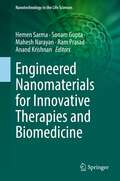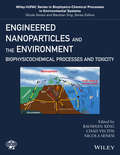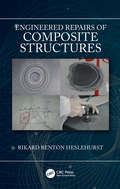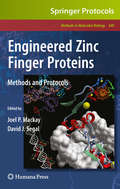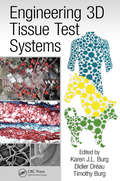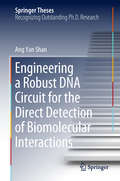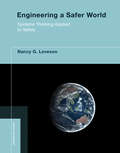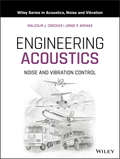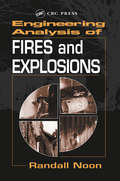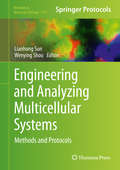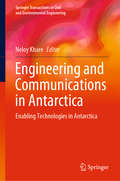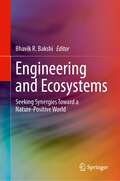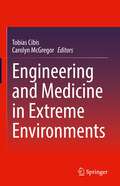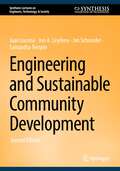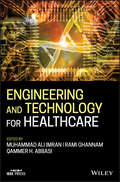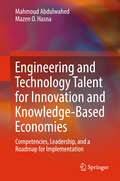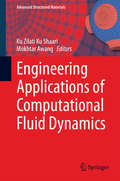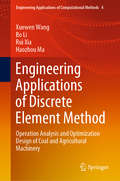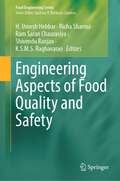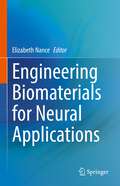- Table View
- List View
Energy Risk Assessment
by Herbert InhaberFirst Published in 1982. Comprehensive and controversial, this book presents an overview of the energy options available and their attendant risks. The entire energy cycle- from raw material to final energy production- is examined in depth so that accurate and detailed assessments can be made of the risks of energy options.
Energy Saving and Carbon Reduction: Approaches for Energy and Chemical Industries
by Tony A. ChenThe book provides an integrated energy/exergy analysis method to identify the energy utilization issues and systematically propose the cost-effective energy-saving and CO2 mitigation/capture solution. There is a strong market needs on energy-saving and greenhouse gas (GHG) reduction. CO2 mitigation/capture will achieve economic benefit of fuel, power, and carbon tax saving as well as environmental GHG reduction. The book is a professional book for energy-saving and GHG gas mitigation technology in oil & gas, oil refining, and chemical industry. It is an integrated technical book that combines energy utilization theory and practical method, including: thermodynamic analysis for unit operation and process units; energy and exergy calculation for various process streams and utilities; three-link energy/exergy analysis model; energy/exergy balance of equipment, process units, and entire plant; approach and technology of energy saving; optimization of pipeline and equipment; pinch energy-saving technology and its application; CO2 capture and utilization with 8 case studies incorporated for all different scenarios; key energy-saving technologies such gas turbine, FCCU regeneration CO combustion and energy recovery, flue gas turbine system optimization, low-grade heat recovery and utilization. The book is intended for engineers and professional personnel who are working in process engineering, EPC companies, chemical and petrochemical plants, refineries, oil & gas production facilities, power generation plant. It can also be a professional reference or textbook for undergraduate or graduate-level university students and teaching personnel of chemical, energy, and process engineering faculties of universities.
Energy-saving Principles and Technologies for Induction Motors
by Wenzhong Ma Lianping BaiA unique guide to the integration of three-phase induction motors with the emphasis on conserving energy • The energy-saving principle and technology for induction motor is a new topic, and there are few books currently available; this book provides a guide to the technology and aims to bringabout significant advancement in research, and play an important role in improving the level of motor energy saving• Includes new and innovative topics such as a case study of energy saving in beam pumping system, and reactive compensation as a means of energy saving• The authors have worked in this area for 20 years and this book is the result of their accumulated research and expertise. It is unique in its integration of three-phase induction motors with the emphasis on conserving energy• Integrates the saving-energy principle, technology, and method of induction motors with on-site experiences, showing readers how to meet the practical needs and to apply the theory into practice. It also provides case studies and analysis which can help solve problems on-site
Energy Security and Cooperation in Eurasia: Power, profits and politics (Routledge Studies in Energy Policy)
by Ekaterina SvyatetsWhy are bilateral relations, especially in the area of energy security, so different in the cases of U.S.-Russia, U.S.-Azerbaijan, and Russia-Germany energy deals? Why do some states find common ground despite differences, while others, with all the seemingly favourable conditions, are sinking into animosity? Energy Security and Cooperation in Eurasia explores varying outcomes of energy cooperation, defined as diplomatic relations, bilateral trade, and investment in oil and natural gas. The book looks at economic potential, geopolitical rivalry, and domestic interest groups in the cases of U.S.-Russia, U.S.-Azerbaijan, and Russia-Germany energy ties. It looks at major projects in each case (Sakhalin and Arctic oil and gas production, Baku-Tbilisi-Ceyhan and Nord Stream pipelines) and activities of international oil companies. The book also provides a detailed analysis of the situation in Ukraine since 2014 and Russia’s annexation of Crimea, and their effect on European energy security. This book utilizes an innovative approach of exploring the dyads of states (bilateral relations) along the economic, geopolitical, and domestic lobbying dimensions. This book is a valuable resource for graduate and undergraduate students, academics and researchers in the areas of Security, Political Economy, Comparative Politics, post-Soviet studies, as well as for general public.
Energy Security and Sustainability
by Atul Sharma Amritanshu ShuklaThere has been ever increasing interest in understanding the various aspects of available resources and production, in terms of need and supply, conservation and environmental impacts and so on. From the current energy scenario, it is very clear that there are serious challenges related in achieving energy sustainability and security worldwide. The aim of this book is to present an overview of progress made towards energy sustainability addressing concerns regarding carbon emission and clean energy resources. Keeping this in mind, the book has chapters on all major energy sources which are being utilized at present, along with those having potential prospects for future.
Energy Security, Equality and Justice
by Benjamin K. Sovacool Roman V. Sidortsov Benjamin R. JonesThis book applies concepts from ethics, justice, and political philosophy to five sets of contemporary energy problems cutting across time, economics, politics, geography, and technology. In doing so, the authors derive two key energy justice principles from modern theories of distributive justice, procedural justice, and cosmopolitan justice. The prohibitive principle states that "energy systems must be designed and constructed in such a way that they do not unduly interfere with the ability of people to acquire those basic goods to which they are justly entitled." The affirmative principle states that "if any of the basic goods to which people are justly entitled can only be secured by means of energy services, then in that case there is also a derivative entitlement to the energy services." In laying out and employing these principles, the book details a long list of current energy injustices ranging from human rights abuses and energy-related civil conflict to energy poverty and pervasive and growing negative externalities. The book illustrates the significance of energy justice by combining the most up-to-date data on global energy security and climate change, including case studies and examples from the electricity supply, transport, and heating and cooking sectors, with appraisals based on centuries of thought about the meaning of justice in social decisions.
Energy Security in Japan: Challenges After Fukushima (Transforming Environmental Politics and Policy)
by Vlado VivodaFor a country already uneasy about energy security, the 2011 earthquake and tsunami, which caused a nuclear catastrophe at the Fukushima nuclear power plant, turned pre-existing Japanese concern about the availability of energy into outright anxiety. The subsequent closure of many nuclear reactors meant Japan needed to replace lost power quickly and so had no choice but to secure additional fossil fuels, undermining Japanese diversification policy and increasing global and regional competition for energy. This switch has been at a cost to the already weak Japanese economy whilst the increase in fossil fuel consumption has caused a significant increase in greenhouse gas emissions. In this book Vlado Vivoda examines the drastically changed environment following the disaster in order to analyse Japan’s energy security challenges and evaluate Tokyo’s energy policy options. Looking at how the disaster exacerbated Japan’s existing energy security challenges, Vivoda considers the best policy options for Japan to enhance national energy security in the future, exploring the main impediments to change and how they might be overcome.
Energy Smart Appliances: Applications, Methodologies, and Challenges
by Antonio Moreno-Munoz Neomar GiacominiEnergy Smart Appliances Enables designers and manufacturers to manage real-world energy performance and expectations by covering a range of potential scenarios and challenges Energy Smart Appliances provides utilities and appliance manufacturers, and designers with new approaches to better understand real-world performance, assess actual energy benefits, and tailor each technology to the needs of their customers. With contributions from a fully international group of experts, including heads of prestigious research organizations and leading universities, and innovation managers of the main appliance manufacturers, Energy Smart Appliances includes discussion on: Enabling technologies for energy smart appliances, covering IoT devices and technology and active energy efficiency measures in residential environments Smart home and appliances, answering questions like ‘Where are we heading in terms of the overall smart homes’ future?’ and ‘What’s the energy impact from smart home devices?’ Demand-side management and demand response, covering overall system/ appliances readiness and ideal energy management scenario to drive demand response Energy smart appliances’ best practices and success stories, including refrigerators, washers, dryers, and more With practical coverage of a wide range of potential scenarios and existing and future challenges, Energy Smart Appliances is an essential learning resource for electrical engineering professionals, equipment manufacturers, and designers, along with postgraduate electrical engineering students and researchers in related fields and programs of study.
Energy, Society and Environment (Routledge Introductions to Environment: Environment and Society Texts)
by David ElliottSociety's use of energy and technology is at heart of many of the most significant environmental problems of recent years, including problems of health, global warming and acid rain. Use of technology has been a major cause of environmental problems but new technology offers many solutions.Energy, Society and Environment is an introduction to energy and energy use, and the interactions between technology, society and the environment. The book is clearly structured to examine:* key environmental issues, and the harmful impacts of energy use* new technological solutions to environmental problems* implementation of possible solutions* implications for society in developing a sustainable approach to energy use.Social processes and strategic solutions to problems are located within a clear, technological context with topical case studies and informative diagrams illustrating key issues.Energy, Society and Environment examines the potential and limits of technical solutions to environmental problems and suggests the social, economic and political changes necessary to avoid serious environmental damage in the future.
Energy, Society and the Environment: Solid-State Hydrogen Storage Materials (SpringerBriefs in Applied Sciences and Technology)
by Ali Salehabadi Mardiana Idayu Ahmad Norli Ismail Norhashimah Morad Morteza EnhessariThis book provides a comprehensive and contemporary overview of advances in energy and energy storage technologies. Although the coverage is varied and diverse, the book also addresses unifying patterns and trends in order to enrich readers’ understanding of energy and energy storage systems, particularly hydrogen energy storage, including e.g. their morphology, porosity and material structure. Readers will also gain insights into the hydrogen storage performance landscape, based on data released by the US Department of Energy (DOE), providing a basis for understanding real-world applications. The book also discusses the superior hydrogen storage performance of solid-state materials and explores the physical and chemical properties that can potentially affect their performance.
Energy Storage: Hybridization of Power-to-Gas Technology and Carbon Capture (Springerbriefs In Energy Ser.)
by Manuel Bailera Pilar Lisbona Begoña Peña Luis M. RomeoThis book presents a detailed analysis of Power-to-Gas, a promising energy storage technology. It discusses the main mechanisms involved, and presents two Power-to-Gas and carbon capture hybridizations. The book begins by providing an introduction to energy storage technologies. It then reviews a number of Power-to-Gas projects now in progress, highlighting the current barriers to commercializing the technology. Moreover, the book presents two novel Power-to-Gas hybridizations, which improve the technology’s applicability in terms of efficiency, utilization of resources and profitability. Given its scope, the book will be of interest to graduate students, researchers and practitioners in the fields of engineering and energy.
Energy Storage
by Yves BrunetEnergy storage examines different applications such as electric power generation, transmission and distribution systems, pulsed systems, transportation, buildings and mobile applications. For each of these applications, proper energy storage technologies are foreseen, with their advantages, disadvantages and limits. As electricity cannot be stored cheaply in large quantities, energy has to be stored in another form (chemical, thermal, electromagnetic, mechanical) and then converted back into electric power and/or energy using conversion systems. Most of the storage technologies are examined: batteries, hydrogen, super capacitors, SMES, flywheels, CAES, thermal storage and hydraulic gravitational storage.
Energy Storage
by Robert HugginsThis is a comprehensive overview of energy storage concepts, methodologies and applications. Students will find chapters exploring the underlying energy storage fundamentals under various conditions, such as organic fuels, phase transitions and heat capacity, in addition to reversible chemical reactions. Important energy storage types such as mechanical, hydrogen and electromagnetic energy storage are discussed in a pedagogical language and structure accessible to students and researchers alike. Valuable coverage of various types of batteries are included, such as metal hydride / "nickel", lithium, lead-acid and primary batteries, in addition to a variety of current applications.
Energy Storage
by Robert A. HugginsEnergy Storage explains the underlying scientific and engineering fundamentals of all major energy storage methods. These include the storage of energy as heat, in phase transitions and reversible chemical reactions, and in organic fuels and hydrogen, as well as in mechanical, electrostatic and magnetic systems. Updated coverage of electrochemical storage systems considers exciting developments in materials and methods for applications such as rapid short-term storage in hybrid and intermittent energy generation systems, and battery optimization for increasingly prevalent EV and stop-start automotive technologies. This nuanced coverage of cutting-edge advances is unique in that it does not require prior knowledge of electrochemistry. Traditional and emerging battery systems are explained, including lithium, flow and liquid batteries. Energy Storage provides a comprehensive overview of the concepts, principles and practice of energy storage that is useful to both students and professionals.
Energy Storage (Advances In Renewable Energy Ser.)
by Umakanta SahooThe world’s energy landscape is very complex. Fossil fuels, especially because of hydraulic fracturing, are still a mainstay of global energy production, but renewable energy sources, such as wind, solar, and others, are increasing in importance for global energy sustainability. Experts and non-experts agree that the next game-changer in this area will be energy storage. Energy storage is crucial for continuous operation of power plants and can supplement basic power generation sources over a stand-alone system. It can enhance capacity and leads to greater security, including continuous electricity supply and other applications. A dependable energy storage system not only guarantees that the grid will not go down, but also increases efficacy and efficiency of any energy system. This groundbreaking new volume in this forward thinking series addresses all of these issues, laying out the latest advances and addressing the most serious current concerns in energy storage. Whether for the veteran engineer or the student, this latest volume in the series, “Advances in Renewable Energy,” is a must-have for any library.
Energy Storage and Conversion Devices: Supercapacitors, Batteries, and Hydroelectric Cells (Emerging Materials and Technologies)
by Anurag GaurThis book presents a state-of-the-art overview of the research and development in designing electrode and electrolyte materials for Li-ion batteries and supercapacitors. Further, green energy production via the water splitting approach by the hydroelectric cell is also explored. Features include: • Provides details on the latest trends in design and optimization of electrode and electrolyte materials with key focus on enhancement of energy storage and conversion device performance • Focuses on existing nanostructured electrodes and polymer electrolytes for device fabrication, as well as new promising research routes toward the development of new materials for improving device performance • Features a dedicated chapter that explores electricity generation by dissociating water through hydroelectric cells, which are a nontoxic and green source of energy production • Describes challenges and offers a vision for next-generation devices This book is beneficial for advanced students and professionals working in energy storage across the disciplines of physics, materials science, chemistry, and chemical engineering. It is also a valuable reference for manufacturers of electrode/electrolyte materials for energy storage devices and hydroelectric cells.
Energy Storage and Conversion Materials: Properties, Methods, and Applications
by Tran, Ngoc Thanh Thuy Jeng-Shiung Jan Wen-Dung Hsu Ming-Fa Lin Jow-Lay HuangThis book explores the fundamental properties of a wide range of energy storage and conversion materials, covering mainstream theoretical and experimental studies and their applications in green energy. It presents a thorough investigation of diverse physical, chemical, and material properties of rechargeable batteries, supercapacitors, solar cells, and fuel cells, covering the development of theoretical simulations, machine learning, high-resolution experimental measurements, and excellent device performance. Covers potential energy storage (rechargeable batteries and supercapacitors) and energy conversion (solar cells and fuel cells) materials Develops theoretical predictions and experimental observations under a unified quasi-particle framework Illustrates up-to-date calculation results and experimental measurements Describes successful synthesis, fabrication, and measurements, as well as potential applications and near-future challenges Promoting a deep understanding of basic science, application engineering, and commercial products, this work is appropriate for senior graduate students and researchers in materials, chemical, and energy engineering and related disciplines.
Energy Storage Applications in Transmission and Distribution Grids (Elements in Grid Energy Storage)
by Hisham OthmanThe application of energy storage within transmission and distribution grids as non-wire alternative solutions (NWS) is hindered by the lack of readily available analysis tools, standardized planning processes, and practical know-how. This Element provides a theoretical basis along with examples and real-world case studies to guide grid planners in the siting, sizing, and lifetime techno-economic evaluation of storage systems. Many applications are illustrated including feeder peak shaving, feeder reliability improvements, transmission reliability, transmission congestion relief, and renewable integration. Three case studies, based on the author's consulting experience, illustrate the versatility of the analysis methods and provide a guide to grid planners while tackling real world problems.
Energy Storage Architecture (Elements in Grid Energy Storage)
by C. Michael HoffEnergy storage systems (ESS) exist in a wide variety of sizes, shapes and technologies. An energy storage system's technology, i.e. the fundamental energy storage mechanism, naturally affects its important characteristics including cost, safety, performance, reliability, and longevity. However, while the underlying technology is important, a successful energy storage project relies on a thorough and thoughtful implementation of the technology to meet the project's goals. A successful implementation depends on how well the energy storage system is architected and assembled. The system's architecture can determine its performance and reliability, in concert with or even despite the technology it employs. It is possible for an energy storage system with a good storage technology to perform poorly when implemented with a suboptimal architecture, while other energy storage systems with mediocre storage technologies can perform well when implemented with superior architectures.
Energy Storage in Electric Power Grids
by Christophe Saudemont Benoît Robyns Gauthier Delille Bruno FrançoisThis book deals with the management and valuation of energy storage in electric power grids, highlighting the interest of storage systems in grid applications and developing management methodologies based on artificial intelligence tools. The authors highlight the importance of storing electrical energy, in the context of sustainable development, in "smart grids", and discuss multiple services that storing electrical energy can bring. Methodological tools are provided to build an energy management system storage following a generic approach. These tools are based on causal formalisms, artificial intelligence and explicit optimization techniques and are presented throughout the book in connection with concrete case studies.
Energy Storage Systems: Optimization and Applications (Engineering Optimization: Methods and Applications)
by Hafiz Muhammad Ali Tapano Kumar Hotta V. K. Mathew Senthilarasu SundaramThis book discusses generalized applications of energy storage systems using experimental, numerical, analytical, and optimization approaches. The book includes novel and hybrid optimization techniques developed for energy storage systems. It provides a range of applications of energy storage systems on a single platform. The book broadly covers—thermal management of electronic components in portable electronic devices; modeling and optimization aspects of energy storage systems; management of power generation systems involving renewable energy; testing, evaluation, and life cycle assessment of energy storage systems, etc. This book will serve as a reference resource for researchers and practitioners in academia and industry.
Energy Storage Technologies in Grid Modernization
by Sandeep Dhundhara Yajvender Pal Verma Ashwani KumarENERGY STORAGE TECHNOLOGIES IN GRID MODERNIZATION Written and edited by a team of experts, this exciting new volume discusses the various types of energy storage technologies, the applications of energy storage systems, their role in the real-time operation of power markets, and the operational issues of modern power systems, including renewable-based generating sources. The worldwide energy sector, specifically power generation, has undergone a huge transformation in recent years, and the focus is to make it sustainable, environmentally friendly, reliable, and highly efficient. As a result, a significant share of highly intermittent but clean renewable sources is being integrated into the power system using advanced technological components. The higher penetration level of renewable energy sources (RESs) has increased the active power generation share in the grid but reduced the total rotating system inertia. This high reduction in inertia brings new challenges and technical issues to the operators of modern power systems and impacts the stability and security of the grid. The stochasticity of these renewable sources also poses a big challenge to the efficient operation of the power system. Electrical energy storage systems help to manage such issues and challenges that occur due to the intermittent nature of RES and can play a big role in the smooth and reliable operation of the power system. The applications and opportunities to use storage on the grid are growing due to the improvements in energy storage technologies, and flexible regulatory frameworks. Technological developments have made it possible to use batteries and other Energy Storage Systems (ESSs) for managing the operation of the power system. This book aims to illustrate the potential of energy storage systems in different applications of the modern power system considering recent advances and research trends in storage technologies. These areas are going to play a very significant role in future smart grid operations. This book discusses the various types of energy storage technologies and promotes the applications of ESSs in the performance improvement of modern power systems. Whether for the veteran engineer, new hire, or student, it is a must-have for any library.
Energy: Supply and Demand
by David B. RutledgeFocusing on trends in energy supply and demand, this text provides students with a comprehensive account of the subject and an understanding of how to use data analysis and modeling to make future projections and study climate impacts. Developments in technology and policy are discussed in depth, including the role of coal, the fracking revolutions for oil and gas, the electricity grid, wind and solar power, battery storage, and biofuels. Trends in demand are also detailed, with analysis of industrial demands such as LEDs, air conditioning, heat pumps, and information technology, and the transportation demands of railroads, ships, and cars (including electric vehicles). The environmental impacts of the energy industry are considered throughout, and a full chapter is dedicated to climate change. Real-life case studies and examples add context, and over 400 full-color figures illustrate key concepts. Accompanied by a package of online resources including solutions, video examples, sample data, and PowerPoint slides, this is an ideal text for courses on energy and is accessible to a range of students from engineering and related disciplines.
Energy Sustainability and Climate Change in ASEAN (Economics, Law, and Institutions in Asia Pacific)
by Han Phoumin Farhad Taghizadeh-Hesary Fukunari Kimura Jun ArimaThis book provides several up-to-date empirical policy-oriented studies on assessing the impacts of climate change on various economic sectors and the role of renewable energy resources in mitigating pollution and climate change. It suggests various policy recommendations on how to increase the share of renewable energy resources in the energy baskets of the members of the Association of Southeast Asian Nations (ASEAN) and the rest of the world to ensure energy sustainability. As of 2020, most of the world’s energy investment still went to carbon-emitting sources, namely, fossil fuels. On the other hand, the Covid-19 pandemic and the economic Project Overview 20 March 2021 08:39 Page 6 of 9 downturns shrank the global energy demand, including fossil fuels, resulting in a sharp drop in their prices. Low fossil fuel prices are harmful to developing renewable energy projects, making solar, wind, and other renewable energy resources less competitive as sources of electricity. This is endangering the Paris agreement and the “Climate Action” goal of the United Nations. Given the high share of fossil fuels in the energy mix of the members of ASEAN, tremendous challenges must be faced for their energy transition in the post-Covid-19 world. The authors call for sound policy and applicable technologies to ensure sustainable energy availability, accessibility, and affordability to reach emission reduction targets.
Energy Sustainability in Built and Urban Environments (Energy, Environment, and Sustainability)
by Emilia Motoasca Avinash Kumar Agarwal Hilde BreeschThis book covers different aspects of energy sustainability in residential buildings and neighborhoods, starting from the construction and design aspects, and moving on to HVAC systems and lighting, and the applications, harvesting, use and storage of renewable energy. The volume focuses on smart and sustainable use of energy, discussing both the technological advancements and the economic, social and environmental impacts. Novel approaches to recycling of waste and materials in the context of residential buildings are also presented. This volume will be of interest to researchers and policy makers working in the fields of renewable energy, sustainable design and city planning.
Energy Sustainability in Built and Urban Environments (Energy, Environment, and Sustainability)
by Emilia Motoasca Avinash Kumar Agarwal Hilde BreeschThis book covers different aspects of energy sustainability in residential buildings and neighborhoods, starting from the construction and design aspects, and moving on to HVAC systems and lighting, and the applications, harvesting, use and storage of renewable energy. The volume focuses on smart and sustainable use of energy, discussing both the technological advancements and the economic, social and environmental impacts. Novel approaches to recycling of waste and materials in the context of residential buildings are also presented. This volume will be of interest to researchers and policy makers working in the fields of renewable energy, sustainable design and city planning.
Energy-Sustainable Advanced Materials
by Mark Alston Timothy N. LambertThis book highlights progress towards the capture, storage, and utilization of energy through the development of advanced materials and systems based on abundant elements, materials, and commodities. Energy is critical to human sustainability and a global-scale deployment of renewable energy systems will be required. Hence, the chapters integrate the fundamental aspects that enable the technical advancements in detail, along with an emphasis on the need for highly sustainable materials to enable real impact for humankind: To determine innovation of energy capture and storage through characterizations of materials in areas of electrical generation and electrical storage systems; To demonstrate better performance, economic and environmental advantages than the current state of the art; To define new chemistries and materials for innovations in energy density design through lower operational temperatures, improve safety, expanding operational voltage, battery durability lifetimes, and reduce system costs. Advances critical technical and commercial objectives for novel high energy density materials;Evaluates operational material models for optimizing energy capture that are integrated by configurations as a system; Illustrates utilization of material life cycle assessment for high energy outputs generators for sustainable materials.
Energy Systems: A New Approach to Engineering Thermodynamics
by Renaud GicquelConsidered as particularly difficult by generations of students and engineers, thermodynamics applied to energy systems can now be taught with an original instruction method. Energy Systems applies a completely different approach to the calculation, application and theory of multiple energy conversion technologies. It aims to create the reader’s foundation for understanding and applying the design principles to all kinds of energy cycles, including renewable energy. Proven to be simpler and more reflective than existing methods, it deals with energy system modeling, instead of the thermodynamic foundations, as the primary objective. Although its style is drastically different from other textbooks, no concession is made to coverage: with encouraging pace, the complete range from basic thermodynamics to the most advanced energy systems is addressed. The accompanying Thermoptim™ portal (http://thermoptim.org) presents the software and manuals (in English and French) to solve over 200 examples, and programming and design tools for exercises of all levels of complexity. The portal explains to the user how to build appropriate models to bridge the technological reality with the theoretical basis of energy engineering. Offering quick overviews through e-learning modules moreover, the portal is user-friendly and enables users to quickly improve their proficiency. Students can freely download the Thermoptim modeling software demo version (available in seven languages), and extended options are available to lecturers. A professional edition is also available and has been adopted by many companies and research institutes worldwide (www.s4e2.com). This volume is intended as a textbook for courses in applied thermodynamics, energy systems, energy conversion and thermal engineering taken by senior undergraduate and graduate-level students in mechanical, energy, chemical and petroleum engineering. Students should already have taken a first-year course in thermodynamics. The refreshing approach and exceptionally rich coverage make it a great reference tool for researchers and professionals as well.
Energy Systems Evaluation: Sustainability Assessment (Green Energy and Technology)
by Jingzheng RenThis book presents various methods for sustainability assessment of energy systems, under various different conditions and scenarios. It answers the questions of how to measure the sustainability of energy systems by adopting appropriate metrics and methods. This book provides readers with a comprehensive view of the frontiers of sustainability assessment methods for energy system analysis. It presents various methodologies, allowing readers to understand: the complete metrics for sustainability assessment; life cycle thinking for sustainability assessment of energy systems; and the advanced sustainability assessment methods for energy systems. This book is of interest to researchers, engineers, decision makers, and postgraduate students within the field of energy systems, sustainability, and decision analysis.
Energy Systems in the Era of Energy Vectors
by Vincenzo Naso Fabio OrecchiniWhat lies beyond the era of fossil fuels? While most answers focus on different primary energy resources, Energy Systems in the Era of Energy Vectors provides a completely new approach. Instead of providing a traditional consumption analysis of classical primary energy resources such as oil, coal, nuclear power and gas, Energy Systems in the Era of Energy Vectors describes and assesses energy technologies, markets and future strategies, focusing on their capacity to produce, exchange, and use energy vectors. Special attention is given to the renewable energy resources available in different areas of the world and made exploitable by the integration of energy vectors in the global energy system. Clear definitions of energy vectors and energy systems are used as the basis for a complete explanation and assessment of up-to-date, available technologies for energy resources, transport and storage systems, conversion and use. The energy vectors scheme allows the potential realization of a worldwide sustainable energy system to fulfill global development expectations by minimizing both the impact on the environment, and the international political frictions for access to limited and concentrated resources. Energy Systems in the Era of Energy Vectors is an informative read for researchers and advanced students in industrial, energy and environmental engineering. It also contains valuable information for managers and technicians working in the energy sector.
Energy Systems Modeling: Principles and Applications
by Hooman FarzanehThis book serves as an introductory reference guide for those studying the application of models in energy systems. The book opens with a taxonomy of energy models and treatment of descriptive and analytical models, providing the reader with a foundation of the basic principles underlying the energy models and positioning these principles in the context of energy system studies. In turn, the book provides valuable insights into the varied applications of different energy models to answer complex questions, including those concerning specific aspects of energy policy measures dealing with issues of supply and demand. Case studies are provided in all of the chapters, offering real-world examples of how existing models fit the classification methods outlined here. The book’s remaining chapters address a broad range of principles and applications, taking the reader from the basic principles involved, to state-of-the-art energy production and consumption processes, using modeling and validation/illustration in case studies to do so. With its in-depth mathematical foundation, this book serves as a comprehensive collection of work on modeling energy systems and processes, taking inexperienced graduate students from the basics through to a high-level understanding of the modeling processes in question, while also providing professionals and academic researchers in the field of energy planning with an up-to-date reference guide covering the latest works.
Energy Technology 2017
by Tao Wang Lei Zhang Neale R. Neelameggham Shadia Ikhmayies Nawshad Haque Jingxi Zhu Donna Post Guillen Elsa Olivetti Mark William Kennedy Jaroslaw W. Drelich Ziqi Sun John A Howarter Fiseha TesfayeThis collection focuses on energy efficient technologies including innovative ore beneficiation, smelting technologies, recycling and waste heat recovery. The volume also covers various technological aspects of sustainable energy ecosystems, processes that improve energy efficiency, reduce thermal emissions, and reduce carbon dioxide and other greenhouse emissions. Papers addressing renewable energy resources for metals and materials production, waste heat recovery and other industrial energy efficient technologies, new concepts or devices for energy generation and conversion, energy efficiency improvement in process engineering, sustainability and life cycle assessment of energy systems, as well as the thermodynamics and modeling for sustainable metallurgical processes are included. This volume also offers topics on CO2 sequestration and reduction in greenhouse gas emissions from process engineering, sustainable technologies in extractive metallurgy, as well as the materials processing and manufacturing industries with reduced energy consumption and CO2 emission. Contributions from all areas of non-nuclear and non-traditional energy sources, such as solar, wind, and biomass are also included in this volume. Papers from the following symposia are presented in the book: Energy Technologies Advances in Environmental Technologies: Recycling and Sustainability Joint Session Deriving Value from Challenging Waste Materials: Recycling and Sustainability Joint Session Solar Cell Silicon
Energy Technology 2018: Carbon Dioxide Management And Other Technologies (The Minerals, Metals & Materials Series)
by Tao Wang Lei Zhang Shadia Ikhmayies Mingming Zhang Amit Pandey Donna Post Guillen Cong Wang Elsa Olivetti Huimin Lu Xiaofei Guan Ziqi Sun Neale R Neelameggham John A. Howarter Dirk Verhulst Allie Anderson York R. Smith Sarma PisupatiThis collection focuses on energy efficient technologies including innovative ore beneficiation, smelting technologies, recycling and waste heat recovery. The volume also covers various technological aspects of sustainable energy ecosystems, processes that improve energy efficiency, reduce thermal emissions, and reduce carbon dioxide and other greenhouse emissions. Papers addressing renewable energy resources for metals and materials production, waste heat recovery and other industrial energy efficient technologies, new concepts or devices for energy generation and conversion, energy efficiency improvement in process engineering, sustainability and life cycle assessment of energy systems, as well as the thermodynamics and modeling for sustainable metallurgical processes are included. This volume also includes topics on CO2 sequestration and reduction in greenhouse gas emissions from process engineering, sustainable technologies in extractive metallurgy, as well as the materials processing and manufacturing industries with reduced energy consumption and CO2 emission. Contributions from all areas of non-nuclear and non-traditional energy sources, such as solar, wind, and biomass are also included in this volume. Papers from the following symposia are presented in the book: Energy Technologies and CO2 Management Advanced Materials for Energy Conversion and Storage Deriving Value from Challenging Waste Streams: Recycling and Sustainability Joint Session Solar Cell Silicon Stored Renewable Energy in Coal
Energy Technology 2019: Carbon Dioxide Management and Other Technologies (The Minerals, Metals & Materials Series)
by Tao Wang Xiaobo Chen Donna Post Guillen Lei Zhang Ziqi Sun Cong Wang Nawshad Haque John A. Howarter Neale R Neelameggham Shadia Ikhmayies York R. Smith Leili Tafaghodi Amit PandeyThis collection addresses the need for sustainable technologies with reduced energy consumption and pollutants and the development and application of alternative sustainable energy to maintain a green environment and energy supply. Contributions focus on energy-efficient technologies including innovative ore beneficiation, smelting technologies, and recycling and waste heat recovery, as well as emerging novel energy technologies. Papers also cover various technological aspects of sustainable energy ecosystems, processes that improve energy efficiency, reduce thermal emissions, and reduce carbon dioxide and other greenhouse emissions. Papers from the following symposia are presented in the book: Energy Technologies and Carbon Dioxide ManagementSolar Cell Silicon Advanced Materials for Energy Conversion and Storage
Energy Technology 2024: Carbon Dioxide Management and Other Technologies (The Minerals, Metals & Materials Series)
by Chukwunwike Iloeje Shafiq Alam Donna Post Guillen Fiseha Tesfaye Lei Zhang Susanna A. C. Hockaday Neale R. Neelameggham Hong Peng Nawshad Haque Onuralp Yücel Alafara Abdullahi BabaThis collection is focused on industrial energy sustainability and CO2 management, including processes that improve energy efficiency and reduce or eliminate industrial GHG emissions. Topics address technology areas such as clean energy technologies, innovative beneficiation, smelting technologies, process intensification, as well as CO2 capture and conversion for industrial applications. Areas of interest include, but are not limited to: · Decarbonizing Materials Processing · Use of low carbon fuels, feedstock, and renewable energy resources for materials processing. · Emerging processes and techniques for industrial CO2 capture, conversion/upgrade · CO2 and other GHG reduction metallurgy in ferrous, non-ferrous and reactive metals processing, including rare-earth metals. · Energy Efficiency & Industrial Electrification · Electrification of industrial process heat and electrified production of energy carriers (e.g., hydrogen, ammonia) · Energy efficiency improvements for materials processing and smart manufacturing for optimized process control · System integration and thermal integration of process heat, waste heat recovery, and other technologies for industrial energy efficiency · Sustainability Analysis · Techno-economic life-cycle, resource efficiency and circular economy modeling of energy-intensive processes and associated material supply chains · The role of energy education and regulation in energy and materials sustainability
Energy Technology and Valuation Issues
by André Dorsman Wim Westerman John L. SimpsonThis volume investigates the impact of energy technology innovations on economic development and presents new areas of research into the financial economics of energy as well as new studies into valuation, electricity pricing and the economic, regulatory and environmental costs of alternative energy sources. Academics and practitioners take a global perspective and present cases from several countries. The book concentrates on three issues: 1) innovation and shocks in energy markets; 2) environment and renewables and 3) fossil fuel regulation. The book will provide a useful resource for anyone with an academic or business interest in energy and value issues. This is the fourth volume in a series on energy organized by the Center for Energy and Value Issues (CEVI). The previous volumes in the series include Financial Aspects in Energy (2011), Energy Economics and Financial Markets (2012) and Perspectives on Energy Risk (2014).
Energy, the Environment, and Sustainability (Mechanical and Aerospace Engineering)
by Efstathios E. MichaelidesEnergy and the Environment explains in simple terms what the energy demand is at the present, what the environmental effects of energy use are, and what can be accomplished to alleviate the environmental effects of energy use and ensure adequate energy supply. Though technical in approach, the text uses simple explanations of engineering processes and systems and algebra-based math to be comprehensible to students in a range of disciplines. Schematic diagrams, quantitative examples, and numerous problems will help students make quantitative calculations. This will assist them in comprehending the complexity of the energy-environment balance, and to analyze and evaluate proposed solutions.
Energy Transfer and Dissipation in Plasma Turbulence: From Compressible MHD to Collisionless Plasma (Springer Theses)
by Yan YangThis book revisits the long-standing puzzle of cross-scale energy transfer and dissipation in plasma turbulence and introduces new perspectives based on both magnetohydrodynamic (MHD) and Vlasov models. The classical energy cascade scenario is key in explaining the heating of corona and solar wind. By employing a high-resolution hybrid (compact finite difference & WENO) scheme, the book studies the features of compressible MHD cascade in detail, for example, in order to approximate a real plasma cascade as “Kolmogorov-like” and to understand features that go beyond the usual simplified theories based on incompressible models. When approaching kinetic scales where plasma effects must be considered, it uses an elementary analysis of the Vlasov–Maxwell equations to help identify the channels through which energy transfer must be dissipated. In addition, it shows that the pressure–strain interaction is of great significance in producing internal energy. This analysis, in contrast to many other recent studies, does not make assumptions about wave-modes, instability or other specific mechanisms responsible for the dynamics – the results are direct consequences of the Vlasov–Maxwell system of equations. This is an important step toward understanding dissipation in turbulent collisionless plasma in space and astrophysics.
Energy Transfer Processes in Polynuclear Lanthanide Complexes (Springer Theses)
by Shun OmagariThis book describes the luminescence mechanism of polynuclear lanthanide complexes, focusing on energy transfer processes using a combination of experimental and theoretical approaches. Lanthanide complexes show intense luminescence from the lanthanide ion through sensitization by the organic ligands. The high chromaticity of the emission and the long lifetimes of the complexes are particularly attractive for applications such as organic light-emitting diodes and bioprobes. Polynuclear lanthanide complexes (coordination polymers and clusters) have attracted considerable interest for functionalization by energy transfer between lanthanide ions. At the same time, such extra processes complicate the luminescence mechanism, hindering the rational design of functional polynuclear lanthanide complexes. Firstly, the book explains the principle of the theoretical methods, and then describes the concentration-quenching mechanism in coordination polymers. It also examines the effect of intrinsic spin–orbit coupling arising from lanthanide ions on the ligand-to-lanthanide energy transfer efficiency and the mechanism of back energy transfer (the opposite of sensitizing energy transfer) in lanthanide clusters. This sets the stage for the final topic: the suppression of back energy transfer by energy transfer between lanthanide ions in lanthanide clusters, which is of critical importance, showing that the lanthanide clusters can be considered a new generation of functional and efficient luminescent material and could also provide a breakthrough in lanthanide photophysics.
Energy Transfers by Conduction
by Abdelhanine BenallouWhile the topic of heat and mass transfer is an old subject, the way the book introduces the concepts, linking them strongly to the real world and to the present concerns, is particular. The scope of the different developments keeps in mind a practical energy engineering view.
Energy Transfers by Convection
by Abdelhanine BenallouWhether in a solar thermal power plant or at the heart of a nuclear reactor, convection is an important mode of energy transfer. This mode is unique; it obeys specific rules and correlations that constitute one of the bases of equipment-sizing equations. In addition to standard aspects of convention, this book examines transfers at very high temperatures where, in order to ensure the efficient transfer of energy for industrial applications, it is becoming necessary to use particular heat carriers, such as molten salts, liquid metals or nanofluids. With modern technologies, these situations are becoming more frequent, requiring appropriate consideration in design calculations. Energy Transfers by Convection also studies the sizing of electronic heat sinks used to ensure the dissipation of heat and thus the optimal operation of circuit boards used in telecommunications, audio equipment, avionics and computers.
Energy Transfers by Radiation
by Abdelhanine BenallouInside industrial furnaces and combustion chambers, energy is essentially exchanged by radiation. It is through the same mechanism that the energy emitted by the Sun spreads through different media to reach the Earth. Developing a sound understanding of the laws underlying energy exchanges by radiation is therefore essential, not only for establishing design equations for industrial equipment, but also for an optimal harvesting of solar energy and a better understanding of climate change phenomena such as the greenhouse effect. Energy Transfers by Radiation establishes the basic laws and equations which support the quantification of energy fluxes transferred between surfaces for situations similar to those usually encountered in industrial processes or in solar energy applications.
Energy Transition
by Bertrand CassoretThis book presents both the importance of energy transition and its associated difficulties. Energy Transition, Second Edition, provides an explanation of the physical concepts of energy and power and also reviews global energy consumption and our dependence on energy. The book discusses the links between the economy and energy. It explains the drawbacks and dangers of different energy sources and tries to compare them. By reviewing future energy resources, it evaluates several transition scenarios. The book shows that the laws of physics prevent the emergence of simple, pleasant solutions, but it proposes potential solutions and encourages readers to develop better processes from energy sources to production to consumption. This book will be of interest to engineers and undergraduate and graduate students studying and working in various fields of energy; producers of fossil, gas, oil, coal, electric, renewable, and nuclear energy; and anyone interested in better understanding these fundamental problems for our future. FEATURES Discusses the current issues with energy transition Covers several energy transition scenarios and their associated difficulties Presents the links between economy and energy Highlights the importance of a global discussion of energy Encourages the development of better, improved processes in energy sources from production to consumption
Energy Transition
by Bernard LachalAlthough most people are aware of the value of developing new energy technologies, the importance of assessing such technologies is only just beginning to be recognized in full. This book, illustrated by real-life examples, fulfils two main objectives. Firstly, it provides an in-depth summary of energy system evaluation methods, the result of decades of work in this area, for the use of researchers, engineers and anybody else interested in the energy sector. Secondly, the vicious cycle of neglect towards in situ evaluation is broken. This neglect is due to its unjust reputation for being “thankless work”: longwinded, expensive, difficult to exploit and undervalued. By scientifically organizing experience acquired over more than 30 years, Energy Transition highlights the considerable usefulness of the approach, not only economically, but also from a human standpoint.
Energy Transition: Financing Consumer Co-Ownership in Renewables
by Jens LowitzschConsumer (co-)ownership in renewable energy (RE) is essential to the overall success of Energy Transition. In June 2018, the European Union agreed on a corresponding enabling framework as part of a recast of the Renewable Energy Directive (RED II). The transposition of these comprehensive rules – in particular those on local RE communities – requires developing, implementing and rolling out business models that broaden the capital participation of consumers. The challenge is to include municipalities and/or commercial investors like SMEs and advance to economies of scale while retaining the benefits of individual consumer participation.This book is addressed to energy consumers in local communities, their municipalities and to the policy makers who represent them. Additionally, non-EU countries, in particular those where rural areas have limited access to energy, e.g. in Asia, Africa and Latin America, may be interested in the benefits of consumer ownership. While demand for energy in developing countries is growing, access to energy is crucial for improving the quality of life. The editor of this book presents a new model of consumer ownership in RE for both the EU and countries worldwide. Part One describes the rationale for consumer ownership in RE with regard to social, organizational, legal and financial conditions. Part Two discusses the issue of financing RE and introduces a new financing technique, the Consumer Stock Ownership Plan (CSOP), comparing it to traditional models. Part Three provides 18 country studies from Europe, North America, South America and Asia, organized so as to enable a cross-country comparison of policy approaches and feasibility. Policy recommendations are based on the results of this survey. Part Four summarizes, compares the best practice cases, presents a cost-benefit analysis of “prosumage” and against this background evaluates the impact on future policy.
Energy Transition: Economic, Social and Environmental Dimensions (Industrial Ecology)
by Syed Abdul Rehman Khan Mirela Panait Felix Puime Guillen Lukman RaimiThis book opens up a critical dimension of energy transition taking in account multidimensional challenges on economic, social and environmental fields. The book discusses the trends in the field of energy transition and evolving practices adopted by public authorities and companies for betterment of environment and society. The editors (4) identify directions and challenges involved in the energy transition. The novelty of this book is the multidisciplinary approach, being presented the economic, social and environmental challenges involved in the energy transition. The energy transition is accompanied by a complex process of changing attitudes and behaviors of energy consumers and producers. The consequences are profound not only economically and environmentally but also socially, renewable energy being a solution for energy poverty reduction and development of rural communities. Therefore, certain social and environmental problems generated by energy poverty are solved by using renewable energy. Moreover, the complexity of the phenomenon is presented not only in terms of the analysis of the main sources of renewable energy but also the ethical aspects involved in the use of sources such as biofuels. In the case of this source, the main problem is whether the use of certain agricultural products for the production of biofuels threatens food security, especially in rural areas. All categories of stakeholders must show responsibility and get involved in this complex process which requires a remarkable technical and financial effort. The energy transition can offer innovative solutions through which the impact of economic activity on the environment is minimized, and in this way, industrial ecology achieves its objectives to support sustainable development. The demands imposed by industrial ecology must shape not only the behavior of oil and gas companies but also of entities involved in the production and consumption of renewable energy. Given the negative externalities generated, companies in the fossil fuel sector have become increasingly socially responsible, their social and environmental performance (non-financial) being presented in detail in the annual sustainability reports to inform stakeholders. Therefore, this book is an important read not only for scholars, but also for those who are interested in ensuring an environmentally sustainable future taking in account energy transition challenges.
Energy Transition and Energy Democracy in East Asia
by Jusen Asuka Dan JinThis is an open access book.The subject of this book is to provide down-to-earth information on what kind of actions are being taken by the Government, Local community, Businesses, Researchers, NGOs on the energy transition in this region. It gives an updated picture of the energy transition in the East Asian countries, where the economic growth, as well as CO2 emission growth, is significant.This book focuses not only on the technological perspective of the energy transition but also on the relationship between democracy and energy transition. Readers of this book can understand what kind of international support and pressure is needed to promote the energy transition in this region.Since energy transition is needed not only for combatting climate change but also for the Green Recovery from the COVID-19 pandemic, publishing this book is very helpful to promote the Green Recovery and the Green New Deal world-widely.
Energy Transition in Brazil (The Latin American Studies Book Series)
by Drielli Peyerl Stefania Relva Vinícius Da SilvaThe book's objective is to present the energy transition process in Brazil over time and offer new perspectives on this process in the eyes of a sustainable future. The book unfolds over 15 chapters covering historical, geopolitical, technological, and economical aspects, as well as aspects conceptually familiar to the energy transition such as public perception, low-carbon technologies, digitalization, Sustainable Development Goals, and even recent topics such as the pandemic of COVID-19. The Brazilian electricity and transport sectors and climate change governance are the main focus of this book. The paths taken throughout this book demonstrate the particularities of Brazil and present this country in a unique and differentiated way in terms of the various approaches to the energy transition. It is a book that brings a multidisciplinary, innovative vision and information published for the first time.
Energy Transition in Metropolises, Rural Areas, and Deserts
by Louis Boisgibault Fahad Al KabbaniEnergy Transition in Metropolises, Rural Areas and Deserts presents detailed field studies of energy transition in Lille, Riyadh, Fayence, Bokhol, Ouarzazate and the Arabian Desert. It analyzes local actions and good practices – according to the resources and constraints involved – in the process of removing the obstacles to the transition. Solutions are sought for the right type of space for buildings, transport, industry and services, and targets are set for Europe, the Middle East and Africa as part of the Paris Climate Agreement. As a pedagogical tool, this book is aimed at not only politicians and professionals, but also any members of the public who wish to learn about changes in production and energy consumption.
Energy Transition in the Baltic Sea Region: Understanding Stakeholder Engagement and Community Acceptance (Routledge Studies in Energy Transitions)
by Farid Karimi and Michael RodiThis book analyses the potential for active stakeholder engagement in the energy transition in the Baltic Sea Region (BSR) in order to foster clean energy deployment. Public acceptability and bottom-up activities can be critical for enduring outcomes to an energy transition. As a result, it is vital to understand how to unlock the potential for public, community and prosumer participation to facilitate renewable energy deployment and a clean energy transition – and, consequently, to examine the factors influencing social acceptability. Focussing on the diverse BSR, this book draws on expert contributions to consider a range of different topics, including the challenges of social acceptance and its policy implications; strategies to address challenges of acceptability among stakeholders; and community engagement in clean energy production. Overall, the authors examine the practical implications of current policy measures and provide recommendations on how lessons learnt from this ‘energy lab region’ may be applied to other regions. Reflecting an interdisciplinary approach in the social sciences, this book is an essential resource for scholars, students and policymakers researching and working in the areas of renewable energy, energy policy and citizen engagement, and interested in understanding the potential for bottom-up, grassroots activities and social acceptability to expedite the energy transition and reanimate democracies.
Energy Transitions
by Olivier Labussière Alain NadaïThis book elucidates what it means to transition to alternative sources of energy and discusses the potential for this energy transition to be a more democratic process. The book dynamically describes a recent sociotechnical study of a number of energy transitions occurring in several countries - France, Germany and Tunisia, and involving different energy technologies - including solar, on/off-shore wind, smart grids, biomass, low-energy buildings, and carbon capture and storage. Drawing on a pragmatist tradition of social inquiry, the authors examine the consequences of energy transition processes for the actors and entities that are affected by them, as well as the spaces for political participation they offer. This critical inquiry is organised according to foundational categories that have defined the energy transition - ‘renewable’ energy resources, markets, economic instruments, technological demonstration, spatiality (‘scale’) and temporality (‘horizon(s)’). Using a set of select case studies, this book systematically investigates the role these categories play in the current developments in energy transitions.
Energy Transitions and Social Psychology: A Sociotechnical Perspective (Routledge Studies in Energy Transitions)
by Paul Upham Paula Bögel Katinka JohansenThis book explains how social psychological concepts can be closely integrated with sociotechnical perspectives of energy transitions. It shows the value of actor-centred analysis that acknowledges the role of individual-level processes within their wider contexts of energy supply and use. In this way, the book connects social psychological and sociological frames of analysis, preserving the value of both, to provide multi-level, analytically extended accounts of energy transitions processes. Sociotechnical thinking is about the interactions of people and technology, including the rules, regulations and institutions involved. Such perspectives help to identify the many forms of path dependency that can make change difficult. Human behaviour plays a strong role in maintaining these path dependencies, but it can also introduce change. This book advocates a deliberately interdisciplinary research agenda that recognises the value of social psychological perspectives when seeking to create new pathways for energy supply and use. At the same time, it also demonstrates the value of sociotechnical perspectives for energy-related social psychology. Energy Transitions and Social Psychology will be of great interest to students and scholars of energy transitions, environmental and energy psychology, sustainable development and innovation studies, as well as students and scholars of environment and energy more generally.
Energy Transmission and Synchronization in Complex Networks
by Nicolás RubidoThis work tackles the problems of understanding how energy is transmitted and distributed in power-grids as well as in determining how robust this transmission and distribution is when modifications to the grid or power occur. The most important outcome is the derivation of explicit relationships between the structure of the grid, the optimal transmission and distribution of energy, and the grid's collective behavior (namely, the synchronous generation of power). These relationships are extremely relevant for the design of resilient power-grid models. To allow the reader to apply these results to other complex systems, the thesis includes a review of relevant aspects of network theory, spectral theory, and novel analytical calculations to predict the existence and stability of periodic collective behavior in complex networks of phase oscillators, which constitute a paradigmatic model for many complex systems.
Energy, Transport, & the Environment
by Oliver Inderwildi Sir David KingSustainable mobility is a highly complex problem as it is affected by the interactions between socio-economic, environmental, technological and political issues. Energy, Transport, & the Environment: Addressing the Sustainable Mobility Paradigm brings together leading figures from business, academia and governments to address the challenges and opportunities involved in working towards sustainable mobility. Key thinkers and decision makers approach topics and debates including: energy security and resource scarcity greenhouse gas and pollutant emissions urban planning, transport systems and their management governance and finance of transformation ·the threats of terrorism and climate change to our transport systems. Introduced by a preface from U.S. Secretary of Energy, Steven Chu and an outline by the editors, Dr Oliver Inderwildi and Sir David King, Energy, Transport, & the Environment is divided into six sections. These sections address and explore the challenges and opportunities for energy supply, road transport, urban mobility, aviation, sea and rail, as well as finance and economics in transport. Possible solutions, ranging from alternative fuels to advanced urban planning and policy levers, will be examined in order to deepen the understanding of currently proposed solutions within the political realities of the dominating economic areas. The result of this detailed investigation is an integrated view of sustainable transport for both people and freight, making Energy, Transport, & the Environment key reading for researchers, decision makers and policy experts across the public and private sectors.
Energy, Transport, & the Environment: Addressing the Sustainable Mobility Paradigm
by Oliver Inderwildi Sir David KingSustainable mobility is a highly complex problem as it is affected by the interactions between socio-economic, environmental, technological and political issues. Energy, Transport, & the Environment: Addressing the Sustainable Mobility Paradigm brings together leading figures from business, academia and governments to address the challenges and opportunities involved in working towards sustainable mobility. Key thinkers and decision makers approach topics and debates including: energy security and resource scarcity greenhouse gas and pollutant emissions urban planning, transport systems and their management governance and finance of transformation·the threats of terrorism and climate change to our transport systems. Introduced by a preface from U.S. Secretary of Energy, Steven Chu and an outline by the editors, Dr Oliver Inderwildi and Sir David King, Energy, Transport, & the Environment is divided into six sections. These sections address and explore the challenges and opportunities for energy supply, road transport, urban mobility, aviation, sea and rail, as well as finance and economics in transport. Possible solutions, ranging from alternative fuels to advanced urban planning and policy levers, will be examined in order to deepen the understanding of currently proposed solutions within the political realities of the dominating economic areas. The result of this detailed investigation is an integrated view of sustainable transport for both people and freight, making Energy, Transport, & the Environment key reading for researchers, decision makers and policy experts across the public and private sectors.
The Energy We See: A Look at Light (Lightning Bolt Books #Exploring Physical Science)
by Jennifer BoothroydLight shines through your kitchen window. A campfire brightens the dark woods. You see light all around you. But where does most light come from? And how does it travel? Read this book to find out! Learn all about matter.
Energy Works
by Janette SchusterNIMAC-sourced textbook <p><p> Energy Works allows students to explore different kinds of energy and see how energy is converted to different forms.
Energy Works: Below-Grade Reader (Building Blocks of Science Literacy Series)
by Janette SchusterLexile range: 520L–670L. Energy Works Below-Grade Reader encourages students to consider energy in all its different forms. Topics include: Energy and Its Forms; Energy Sources; the Science and Engineering Practices of analyzing data; and a look into the daily life of an electrical engineer.
La enfermedad y sus metáforas | El sida y sus metáforas
by Susan SontagEste volumen reúne los ensayos, La enfermedad y sus metáforas y El sida y sus metáforas, que siguen ejerciendo una influencia enorme en la reflexión médica y en las vidas de miles de pacientes y cuidadores. Susan Sontag escribió La enfermedad y sus metáforas en 1978, mientras se trataba de un cáncer. En el libro quiso demostrar cómo los mitos acerca de algunas enfermedades, en especial del cáncer, añaden más dolor al sufrimiento de los pacientes y a menudo los cohíben en la búsqueda de tratamiento adecuado. Casi una década después, con la irrupción de una nueva enfermedad estigmatizada y transida de incertidumbres y «fantasías punitivas», Sontag escribió El sida y sus metáforas, extendiendo los argumentos del libro anterior a la pandemia de sida. Reseña:«Un ensayo luminoso.»Cristina Peri Rossi
Enfoque del compromiso religioso y la orientación religiosa: entre los cristianos que se identifican como cristianos
by DRA PENSACOLA H JEFFERSONEL COMPROMISO CON LA RELACIÓN DE ALIANZA CON CRISTO PUEDE AFECTARLE Este estudio consistió en explorar la relación entre el foco de compromiso religioso y la orientación religiosa desde el compromiso relacional con Cristo entre los cristianos que se identifican como cristianos. El objetivo era descubrir una relación entre el compromiso religioso dedicado (foco de) y la orientación religiosa intrínseca, entre los cristianos que se identifican como cristianos, con el fin de responder a la pregunta de investigación. Para ello, se examinaron las medidas de compromiso relacional y orientación religiosa mediante un análisis de correlación y una regresión lineal. Los resultados revelaron que existe una relación directa muy fuerte (r = 0,777) entre un enfoque de compromiso religioso dedicado con Cristo y la orientación religiosa intrínseca.
Enforcing Normalcy: Disability, Deafness, and the Body
by Lennard J. DavisThis book tries to think through some of the complex issues raised by concepts such as the body, the normal, the abnormal, disability, the disabled, and people with disabilities. I wrote this book because I believe deeply that people with disabilities, Deaf people, and others who might not even consider themselves as having a disability have been relegated to the margins by the very people who have celebrated and championed the emergence of multiculturalism, class consciousness, feminism, and queer studies from the margins.
Engagement with Sustainable Development in Higher Education: Universities as Transformative Spaces for Sustainable Futures (Sustainable Development Goals Series)
by Mustafa ÖztürkThis edited volume analyzes cases of higher education programs engaging with sustainable development. Offering cases from across the globe that focus on the role of universities in promoting societal transformations and building sustainable futures, the volume specifically discusses how higher education institutions can educate for the Sustainable Development Goals (SDGs). As critical spaces for research, development, and innovation, higher education institutions are fundamental change agents for societal transformations. Their role in disseminating sustainability through different paths is undeniable, and it is worth discussing the dimensions that surround the concept of sustainability within universities. Considering the role of policy, curriculum, practice, teaching, research, and development paths in universities, this book looks at the contributions of higher education sector to our vision of sustainable development. This publication offers readers a chance to look at different higher education institutions’ engagement with sustainable development through political, managerial, curricular and practical steps.
Engaging the Everyday: Environmental Social Criticism and the Resonance Dilemma
by John M. MeyerAn argument that environmental challenges will only resonate with citizens of affluent postindustrial countries if sustainability concerns emerge from everyday practices. Far-reaching efforts to address environmental issues rarely seem to resonate with citizens of the United States or other wealthy postindustrial societies. In Engaging the Everyday, John Meyer considers this impediment to action on environmental problems—which he terms “the resonance dilemma”—and argues that an environmental agenda that emerges from everyday concerns would resonate more deeply with ordinary citizens. Meyer explores the contours of this alternative, theorizing both obstacles and opportunities and then considering it in terms of three everyday areas of material practice: land use, transportation by automobile, and home dwelling. Adopting the stance of an “inside critic” (neither detached theorist nor narrow policy advocate), and taking an approach that he calls “contested materiality,” Meyer draws on a variety of theoretical perspectives to construct a framework for understanding material practices. He reimagines each of the three material practices in terms of a political idea: for land, property; for automobiles, freedom; and for homes, citizenship. His innovative analysis offers a grounded basis for reshaping our talk about political concepts and values.
Engaging the Public with Climate Change: Behaviour Change and Communication
by Lorraine Whitmarsh Irene Lorenzoni Saffron O'NeillDespite increasing public awareness of climate change, our behaviours relating to consumption and energy use remain largely unchanged. This book answers the urgent call for effective engagement methods to foster sustainable lifestyles, community action, and social change. Written by practitioners and academics, the chapters combine theoretical perspectives with case studies and practical guidance, examining what works and what doesn't, and providing transferable lessons for future engagement approaches. Showcasing innovative thought and approaches from around the world, this book is essential reading for anyone working to foster real and lasting behavioural and social change.
Engaging with Contemporary Challenges through Science Education Research: Selected papers from the ESERA 2019 Conference (Contributions from Science Education Research #9)
by Tamer G. Amin Olivia Levrini Mariana Levin Giulia Tasquier Laura BranchettiThis book starts with the premise that beauty can be an engine of transformation and authentic engagement in an increasingly complex world. It presents an organized picture of highlights from the 13th European Science Education Research Association Conference, ESERA 2019, held in Bologna, Italy. The collection includes contributions that discuss contemporary issues such as climate change, multiculturalism, and the flourishing of new interdisciplinary areas of investigation, including the application of cognitive neuroscience, artificial intelligence, and digital humanities to science education research. It also highlights learners’ difficulties engaging with socio-scientific issues in a digital and post-truth era. The volume demonstrates that deepening our understanding is the preferred way to address these challenges and that science education has a key role to play in this effort. In particular, the book advances the argument that the deep and novel character of these challenges requires a collective search for new narratives and languages, an expanding knowledge base and new theoretical perspectives and methods of research. The book provides a contemporary picture of science education research and looks to the theoretical and practical societal challenges of the future.
Engendering Climate Change: Learnings from South Asia
by Asha Hans Nitya Rao Anjal Prakash Amrita PatelThis book focuses on the gendered experiences of environmental change across different geographies and social contexts in South Asia and on diverse strategies of adapting to climate variability. The book analyzes how changes in rainfall patterns, floods, droughts, heatwaves and landslides affect those who are directly dependent on the agrarian economy. It examines the socio-economic pressures, including the increase in women’s work burdens both in production and reproduction on gender relations. It also examines coping mechanisms such as male migration and the formation of women’s collectives which create space for agency and change in rigid social relations. The volume looks at perspectives from India, Pakistan, Bangladesh and Nepal to present the nuances of gender relations across borders along with similarities and differences across geographical,socio-cultural and policy contexts. This book will be of interest to researchers and students of sociology, development, gender, economics, environmental studies and South Asian studies. It will also be useful for policymakers, NGOs and think tanks working in the areas of gender, climate change and development.
Engine Exhaust Particulates (Energy, Environment, and Sustainability)
by Avinash Kumar Agarwal Atul Dhar Nikhil Sharma Pravesh Chandra ShuklaThis book provides a comparative analysis of both diesel and gasoline engine particulates, and also of the emissions resulting from the use of alternative fuels. Written by respected experts, it offers comprehensive insights into motor vehicle particulates, their formation, composition, location, measurement, characterisation and toxicology. It also addresses exhaust-gas treatment and legal, measurement-related and technological advancements concerning emissions. The book will serve as a valuable resource for academic researchers and professional automotive engineers alike.
The Engine of Complexity: Evolution as Computation
by John MayfieldThe concepts of evolution and complexity theory have become part of the intellectual ether permeating the life sciences, the social and behavioral sciences, and more recently, management science and economics. In this new title, John Mayfield elegantly synthesizes core concepts from across disciplines to offer a new approach to understanding how evolution works and how complex organisms, structures, organizations, and social orders can and do arise based on information theory and computational science.This is a big picture book intended for the intellectually adventuresome. While not deeply technical or mathematical in style, the text challenges readers and rewards them with a nuanced understanding of evolution and complexity that offers consistent, durable, and coherent explanations for major aspects of our life experiences. Numerous examples throughout the book illustrate evolution and complexity formation in action and highlight the core function of computation lying at the heart of the book.
The Engine of Complexity
by John MayfieldThe concepts of evolution and complexity theory have become part of the intellectual ether permeating the life sciences, the social and behavioral sciences, and more recently, management science and economics. In this new title, John Mayfield elegantly synthesizes core concepts from across disciplines to offer a new approach to understanding how evolution works and how complex organisms, structures, organizations, and social orders can and do arise based on information theory and computational science.This is a big picture book intended for the intellectually adventuresome. While not deeply technical or mathematical in style, the text challenges readers and rewards them with a nuanced understanding of evolution and complexity that offers consistent, durable, and coherent explanations for major aspects of our life experiences. Numerous examples throughout the book illustrate evolution and complexity formation in action and highlight the core function of computation lying at the heart of the book.
The Engine of Complexity: Evolution as Computation
by John MayfieldThe concepts of evolution and complexity theory have become part of the intellectual ether permeating the life sciences, the social and behavioral sciences, and, more recently, management science and economics. In this book, John E. Mayfield elegantly synthesizes core concepts from multiple disciplines to offer a new approach to understanding how evolution works and how complex organisms, structures, organizations, and social orders can and do arise based on information theory and computational science. Intended for the intellectually adventuresome, this book challenges and rewards readers with a nuanced understanding of evolution and complexity that offers consistent, durable, and coherent explanations for major aspects of our life experiences. Numerous examples throughout the book illustrate evolution and complexity formation in action and highlight the core function of computation lying at the work's heart.
The Engine of Complexity: Evolution as Computation
by John E. MayfieldThe concepts of evolution and complexity theory have become part of the intellectual ether permeating the life sciences, the social and behavioral sciences, and more recently, management science and economics. In this new title, John Mayfield elegantly synthesizes core concepts from across disciplines to offer a new approach to understanding how evolution works and how complex organisms, structures, organizations, and social orders can and do arise based on information theory and computational science. This is a big picture book intended for the intellectually adventuresome. While not deeply technical or mathematical in style, the text challenges readers and rewards them with a nuanced understanding of evolution and complexity that offers consistent, durable, and coherent explanations for major aspects of our life experiences. Numerous examples throughout the book illustrate evolution and complexity formation in action and highlight the core function of computation lying at the heart of the book.
Engine Oils and Automotive Lubrication (Mechanical Engineering Ser. #80)
by Wilfried J. BartzDiscusses all the major aspects of automotive and engine lubrication - presenting state-of-the-art advances in the field from both research and industrial perspectives. This book should be of interest to mechanical, lubrication and automotive engineers, automotive and machinery designers as well as undergraduate and graduate students in these fields.
Engineer In The Garden
by Colin TudgeToday we are developing a science that could change the world - for good or ill - more quickly and more profoundly than ever before. The science of genetics promises - or threatens - nothing less than the creation of life. Colin Tudge leads the reader gently through the deepest intricacies of genetics. He traces its history. He explores its awesome power and its current applications. And he speculates on its thrilling - or terrifying - future. He has written an essential book for anyone interested in the future of the human race.
An Engineer Like Me
by Dr Shini SomaraInventive illustrations and an empowering story combine to introduce young readers to the world of engineering, creative thinking and problem-solving.Zara is curious about everything! Travelling around the city with her gran, she sees all kinds of fascinating things. How do roller coasters do loop-the-loops? How do planes stay up? As she marvels about how they work, Zara learns about some of the brilliant engineers who have shaped the world around her. Soon she can't wait to start creating her own amazing inventions and become an engineer too!With pages encouraging kids to try out their very own engineering experiments such as constructing the perfect paper aeroplane and safely dropping an egg from a height, this brilliant picture book written by engineer and TV presenter Dr Shini Somara unlocks a love of engineering and celebrates women in STEM.The first book in an exciting new series. Still to come:- A Scientist Like Me- A Coder Like Me- A Mathematician Like Me
Engineered Antimicrobial Surfaces (Materials Horizons: From Nature to Nanomaterials)
by S. Snigdha Sabu Thomas E. K. Radhakrishnan Nandakumar KalarikkalThis volume looks at the different aspects involved in controlling microbial growth and the techniques employed in obtaining sterile surfaces. It covers research on coatings, nano-materials, herbal materials, naturally occurring antimicrobials in designing antimicrobial surfaces. It discusses issues of antibiotic resistance, synthesis techniques, toxicity, and current and potential applications of antimicrobial surfaces, and this book will serve as a useful reference to a broad range of scientists, industrial practitioners, graduate and undergraduate students, and other professionals in the fields of polymer science and engineering, materials science, surface science, bioengineering and chemical engineering.
Engineered Biochar: Fundamentals, Preparation, Characterization and Applications
by Sudipta Ramola Dinesh Mohan Ondrej Masek Ana Méndez Toshiki TsubotaThis book systematically covers the fundamentals and applications of modified biochar. The 19 chapters are divided into 3 sections that provide a holistic overview for researchers from all related fields. Section 1 and 2 present the pyrolysis process, including the advantages and limitations of the physical, chemical, and biological modification methods and characterization of modified biochar. Section 3 highlights the wide spectrum of applications of modified biochar in fuel cells and batteries, remediation of organic and inorganic contaminants from soil and water and soil fertilization. Given its scope, the book appeals to a broad readership in various fields of chemical engineering, materials science, and environmental science.
Engineered Biomaterials: Synthesis and Applications (Engineering Materials)
by Rishabha Malviya Sonali SundramThis book highlights recent advances focusing on the synthesis methods of engineered biomaterials and their applications. The book discusses recent applications of various approaches and technology in improving the functional properties and biological activities of biopolymers. It includes two major sections: the first section introduces a range of methods which lead to materials with enhanced properties for a range of practical applications, along with the positives and limitations of the techniques. The second section covers recent trends and advances in application of engineered biomaterials that assist materials scientists and researchers in mapping out the future of these new improved materials through value addition in order to enhance their use. Contributions in the book are done by prominent researchers from industry, academia, and government/private research laboratories across the globe. The book summarizes in a fairly comprehensive manner many of the recent technical advancements in the area of biopolymers. The book is intended to serve as a reference resource in the area of polymers science.
Engineered Carbohydrate-Based Materials for Biomedical Applications
by Ravin NarainThis book addresses the need for a comprehensive book on the design, synthesis, and characterization of synthetic carbohydrate-based polymeric materials along with their biological applications. The first two chapters cover the synthesis and self-assembly of glycopolymers and different techniques for creating these synthetic polymers. Subsequent chapters account for the preparation of block copolymers, branched glycopolymers, glycosurfaces, glycodendrimers, cationic glycopolymers, bioconjugates, glyconanoparticles and hydrogels. While these chapters comprehensively review the synthetic and characterization methods of those carbohydrate-based materials, their biological applications are discussed in detail.
Engineered Living Materials
by Wil V. SrubarThis book will serve as a primer for readers to understand recent advances, applications, and current challenges in the field of Engineered Living Materials. The chapters cover core science and engineering research areas, including (1) advances in synthetic biology and genetic programmability for Engineered Living Materials, (2) functional Engineered Living Material for application in energy, electronics, and construction, and (3) novel manufacturing approaches for Engineered Living Materials at multiple scales. The emerging field of Engineered Living Materials represents a significant paradigm shift in materials design and synthesis, in which living cells are used to impart biologically active functionalities to manmade materials. The result is a genetically programmable augmentation of non-living matter to exhibit unprecedented life-like (i.e., living) capabilities. At the intersection of synthetic biology and materials science, the field of Engineered Living Materials exhibits unprecedented promise and potential to alter the way we synthesize new materials and design medical devices, fabrics, robotics, commodity polymers, and construction materials. Materials with attributes of living systems can be engineered with an ability to respond to their environment and designed to self-repair in response to physical or other stresses or detect the presence of specific stimuli, such as light, heat, pressure, or hazardous chemical compounds. Although nascent, scientists and researchers in the field of Engineered Living Materials have made marked advances in demonstrating a potential to revolutionize a multitude of science and engineering disciplines. This volume will define the current state of the art of Engineered Living Materials, and highlight grand opportunities and challenges that abound at the nexus of synthetic biology and materials science and engineering.
Engineered Nanomaterials for Innovative Therapies and Biomedicine (Nanotechnology in the Life Sciences)
by Ram Prasad Mahesh Narayan Anand Krishnan Hemen Sarma Sonam GuptaResearch on biomedical applications of nanomaterials has exhibited the rapidly evolving field of biomedical sciences by showing how effective they are in treatment. These particles hold considerable potential for biomedical applications. Work is ongoing, and the results suggest a possibility for a sustainable future for nanomaterials in both therapeutic and biomedical fields. This book highlights current and emerging applications, taking global research findings into consideration. We believe the focus on the identification and role of nanomaterial applications in therapeutic and biomedical sciences can lead to novel solutions in the fields. The chapters of this book are disseminated in a manner that can be readily adopted as sources for new and further study. The editors integrate advanced texts in their research that help graduate students, researchers and professors. Additionally, we believe that international readers will be able to make use of this book for reference purposes.
Engineered Nanoparticles and the Environment: Biophysicochemical Processes and Toxicity
by Baoshan Xing Chad D. Vecitis Nicola SenesiDetails the source, release, exposure, adsorption, aggregation, bioavailability, transport, transformation, and modeling of engineered nanoparticles found in many common products and applications Covers synthesis, environmental application, detection, and characterization of engineered nanoparticles Details the toxicity and risk assessment of engineered nanoparticles Includes topics on the transport, transformation, and modeling of engineered nanoparticles Presents the latest developments and knowledge of engineered nanoparticles Written by world leading experts from prestigious universities and companies
Engineered Repairs of Composite Structures
by Rikard Benton HeslehurstEngineered Repairs of Composite Structures provides a detailed discussion, analysis, and procedures for effective and efficient repair design of advanced composite structures. It discusses the identification of damage types and the effect on structural integrity in composite structures, leading to the design of a repair scheme that focusses on the restoration of the structural integrity and damage tolerance. This book teaches the reader to better understand effective and efficient repair design, allowing for more structurally effective repairs of damaged composite structures. It also discusses the application of the repair and what is needed in the forming of the composite repair to meet the engineering design requirements. Aimed at materials engineers, mechanical engineers, aerospace engineers, and civil engineers, this practical work is a must have for any industry professional working with composite structures.
Engineered Zinc Finger Proteins
by Joel P. Mackay David J. SegalAmong the many types of DNA binding domains, C2H2 zinc finger proteins (ZFPs) have proven to be the most malleable for creating custom DNA-binding proteins. In Engineered Zinc Finger Proteins: Methods and Protocols, expert researchers from some of the most active laboratories in this field present detailed methods, guidance, and perspectives. The volume contains sections covering the engineering of ZFPs, methods for the creation, evaluation, and delivery of artificial transcription factors (ATFs), methods for the creation and evaluation of zinc finger nucleases (ZFNs), and a collection of the several applications and assays beyond ATFs and ZFNs, including zinc finger transposases and ChIP-seq methodology amongst other subjects. Written in the highly successful Methods in Molecular BiologyTM series format, chapters include introductions to their respective topics, lists of the necessary materials and reagents, step-by-step, readily reproducible laboratory protocols, and notes on troubleshooting and avoiding known pitfalls. Comprehensive and cutting-edge, Engineered Zinc Finger Proteins: Methods and Protocols aims to aid both seasoned practitioners and new investigators with its vital methods and insights as they seek to create the next generation of engineered ZFPs and applications.
Engineering 3D Tissue Test Systems
by Karen J. L. Burg, Didier Dréau and Timothy BurgEngineering 3D Tissue Test Systems provides an introduction to, and unique coverage of, a rapidly evolving area in biomaterials engineering. It reveals the current and future research responses, the current and future diagnostic applications, and provides a comprehensive overview to foster innovation. It offers insight into the importance of 3D systems and their use as benchtop models, spanning applications from basic scientific research to clinical diagnostics. Methods and limitations of building 3D tissue structures are evaluated, with attention given to the cellular, polymeric, and fabrication instrumentation components. The book covers the important aspects of polymeric tissue test systems, highlighting the needs and constraints of the industry, and includes a chapter on regulatory and pricing issues.
Engineering a Robust DNA Circuit for the Direct Detection of Biomolecular Interactions (Springer Theses)
by Ang Yan ShanThis book provides essential insights into designing a localized DNA circuit to promote the rate of desired hybridization reactions over undesired leak reactions in the bulk solution. The area of dynamic DNA nanotechnology, or DNA circuits, holds great promise as a highly programmable toolbox that can be used in various applications, including molecular computing and biomolecular detection. However, a key bottleneck is the recurring issue of circuit leakage. The assembly of the localized circuit is dynamically driven by the recognition of biomolecules – a different approach from most methods, which are based on a static DNA origami assembly. The design guidelines for individual reaction modules presented here, which focus on minimizing circuit leakage, are established through NUPACK simulation and tested experimentally – which will be useful for researchers interested in adapting the concepts for other contexts. In the closing section, the design concepts are successfully applied to the biomolecular sensing of a broad range of targets including the single nucleotide mutations, proteins, and cell surface receptors.
Engineering a Safer World: Systems Thinking Applied to Safety (Engineering Systems)
by Nancy G. LevesonA new approach to safety, based on systems thinking, that is more effective, less costly, and easier to use than current techniques.Engineering has experienced a technological revolution, but the basic engineering techniques applied in safety and reliability engineering, created in a simpler, analog world, have changed very little over the years. In this groundbreaking book, Nancy Leveson proposes a new approach to safety—more suited to today's complex, sociotechnical, software-intensive world—based on modern systems thinking and systems theory. Revisiting and updating ideas pioneered by 1950s aerospace engineers in their System Safety concept, and testing her new model extensively on real-world examples, Leveson has created a new approach to safety that is more effective, less expensive, and easier to use than current techniques.Arguing that traditional models of causality are inadequate, Leveson presents a new, extended model of causation (Systems-Theoretic Accident Model and Processes, or STAMP), then shows how the new model can be used to create techniques for system safety engineering, including accident analysis, hazard analysis, system design, safety in operations, and management of safety-critical systems. She applies the new techniques to real-world events including the friendly-fire loss of a U.S. Blackhawk helicopter in the first Gulf War; the Vioxx recall; the U.S. Navy SUBSAFE program; and the bacterial contamination of a public water supply in a Canadian town. Leveson's approach is relevant even beyond safety engineering, offering techniques for “reengineering” any large sociotechnical system to improve safety and manage risk.
Engineering Acoustics: Noise and Vibration Control (Wiley Series in Acoustics Noise and Vibration)
by Malcolm J. Crocker Jorge P. ArenasA comprehensive evaluation of the basic theory for acoustics, noise and vibration control together with fundamentals of how this theoretical material can be applied to real world problems in the control of noise and vibration in aircraft, appliances, buildings, industry, and vehicles. The basic theory is presented in elementary form and only of sufficient complication necessary to solve real practical problems. Unnecessary advanced theoretical approaches are not included. In addition to the fundamental material discussed, chapters are included on human hearing and response to noise and vibration, acoustics and vibration transducers, instrumentation, noise and vibration measurements, and practical discussions concerning: community noise and vibration, interior and exterior noise of aircraft, road and rail vehicles, machinery noise and vibration sources, noise and vibration in rapid transit rail vehicles, automobiles, trucks, off road vehicles, and ships. In addition, extensive up to date useful references are included at the end of each chapter for further reading. The book concludes with a glossary on acoustics, noise and vibration
Engineering Analysis of Fires and Explosions
by Randall K. NoonEngineering Analysis of Fires and Explosions demonstrates how professional forensic engineers apply basic concepts and principles from engineering and scientific disciplines to analyze fires and explosions. It describes how forensic engineers use a "reverse design" process to determine the original cause of a fire or explosion. This guide incorporates practices and lessons learned from the first-hand experiences of the author and his colleagues. It is an exciting introduction to the multidisciplinary subject of fire and explosion analysis and its legal ramifications. The author's straightforward language and style make the concepts easy to understand.
Engineering and Analyzing Multicellular Systems
by Lianhong Sun Wenying ShouEngineering Multicellular Systems: Methods and Protocols, focuses on laboratory procedures used in recent efforts for constructing synthetic multicellular systems and their applications. In particular, constructing multicellular systems to form various microbial ecosystems has been extensively explored to examine evolution and interactions of microbial ecosystems, while co-cultures have emerged as an efficient tool to produce some complex chemical molecules. Written in the highly successful Methods in Molecular Biology series format, chapters include introductions to their respective topics, lists of the necessary materials and reagents, step-by-step, readily reproducible laboratory protocols and key tips on troubleshooting and avoiding known pitfalls. Engineering Multicellular Systems: Methods and Protocols provide a comprehensive laboratory protocol reference for constructing multicellular systems for various applications.
Engineering and Communications in Antarctica: Enabling Technologies in Antarctica (Springer Transactions in Civil and Environmental Engineering)
by Neloy KhareIndia launched its maiden scientific expedition to Antarctica way back in 1981 and ever since annual expeditions are launched to address thematic research in the contemporary areas of Antarctic Science and Engineering. The initial efforts and achievements of India are not only significant but are of historical importance.This book discusses a wide array of topics that have entered the mainstream of geotechnical and geo environmental engineering over the initial two and half decades of India’s presence in the icy continent ‘Antarctica’. At the same time, it highlights the lessons learnt in cryo-engineering technologies. It covers various articles on many aspects of environmental science and collates the overall achievements in the fascinating field of Antarctic engineering and environmental impact assessment. Accordingly, this book covers articles on wind energy by Ramesh et al., and engineering aspects in Antarctica by Rai. Similarly, Pathak has reviewed the engineering details of Dakshin Gangotri and Maitri. On the contrary, Sharma has provided an interesting history about the process of establishment of Dakshin Gangotri station. Similarly, communication aspects have been highlighted by Dhaka. Commercial polymers and their utility in cold region have been discussed by Dabholker et al. Besides, Tiwari and Khare have reviewed the environmental studies carried out during the initial 25 years in Antarctic research base ‘Maitri’. Similarly, Ramchandran and Sathe have studied the natural radioactivity in Antarctica while fire safety in Antarctica has been touched upon by Chatterjee. On the other hand, Veerbhadraiah and Jain have provided a status on environmental management services at Maitri station Additionally Tiwari has provided details on the new Indian Research Base ‘Bharti’ at Larsemann Hills region. It provides a one-stop reference for researchers and those working in industry and government.
Engineering and Ecosystems: Seeking Synergies Toward a Nature-Positive World
by Bhavik R. BakshiThis book demonstrates how the inclusion of nature in engineering decisions results in innovative solutions that are economically feasible, ecologically viable, and socially desirable. It advances progress toward nature-positive decisions by protection and restoration of ecosystems and respect for ecological boundaries. The topic of this book is an active area of academic research, and leading companies are including goals associated with ecosystem services in their sustainability plans. This book is the first collection of methods and applications that explicitly include the role of nature in supporting engineering activities and describes the role that ecosystems play in supporting technology and industry. It describes approaches, models, applications, and challenges for innovation and sustainability that will be useful to students and practitioners.
Engineering and Medicine in Extreme Environments
by Tobias Cibis Carolyn McGregor AmThis book brings together in-depth information on a wide array of bio-engineering topics and their application to enhance human health, performance, comfort, and survival in extreme environments. Contributions from biomedical engineering, information systems, medicine and physiology, and medical engineering are presented in relation to a broad range of harsh and extreme environmental scenarios, including underwater, terrestrial (both natural and man-made), and space travel. Physicians, engineers, and scientists, as well as researchers and graduate students, will find the book to be an invaluable resource.Details effects of extreme environments on human physiology;Presents human-environment interaction in different scenarios;Overview of engineering challenges and problems in extreme environments.
Engineering and Sustainable Community Development (Synthesis Lectures on Engineers, Technology, & Society)
by Juan Lucena Jon A. Leydens Jen Schneider Samantha TempleThis book presents an overview of engineering as it relates to humanitarian engineering, service-learning engineering, peace engineering, or engineering for community-led development, programs that are often grouped under Engineering for Good or Engineering for Change. By placing “community” at the center of these endeavors, this book invites readers and practitioners to strive for sustainable community development (SCD). This 2nd edition is centered on new concepts of community-led development and includes topics on the history of engineers and development, the problems of using industry-based practices when designing for communities, how engineers can prepare to work with communities, and listening in community development. Two case studies are provided to highlight the book’s concepts using first-hand experiences of engineers engaged with communities—one of engineers developing a windmill for a community in India, and a second of an engineer mapping communities in Honduras for improved water management. The book concludes with student perspectives and experiences from a curricular model focused on engineering for sustainable community development. Overall, the text invites engineers to reflect and prepare themselves for global careers that involve international development in both the for-profit and non-profit sectors. This 2nd edition places community-led practices at the heart of these endeavors. The book is for engineering faculty, students and practicing engineers, involved in current or future community collaborations. The authors wrote this book with a goal to help readers critically reflect on their own practices and perceptions. Readers learn to question past, current, and future frameworks in the project of development, and are encouraged to adopt practices of community-led development. This 2nd edition is aimed at engineering students who, as future global engineers, are faced with opportunities and challenges when working with communities. As funding for renewable energy, “green jobs,” and community-based initiatives continue to increase, engineers will need to rely on the social and historical concepts presented in this book.
Engineering and Technology for Healthcare (Wiley - IEEE)
by Muhammad Ali Imran Qammer H. Abbasi Rami GhannamInnovation in healthcare is currently a “hot” topic. Innovation allows us to think differently, to take risks and to develop ideas that are far better than existing solutions. Currently, there is no single book that covers all topics related to microelectronics, sensors, data, system integration and healthcare technology assessment in one reference. This book aims to critically evaluate current state-of-the-art technologies and provide readers with insights into developing new solutions. With contributions from a fully international team of experts across electrical engineering and biomedical fields, the book discusses how advances in sensing technology, computer science, communications systems and proteomics/genomics are influencing healthcare technology today.
Engineering and Technology Talent for Innovation and Knowledge-Based Economies: Competencies, Leadership, and a Roadmap for Implementation
by Mahmoud Abdulwahed Mazen O. HasnaThis book introduces and analyzes the models for engineering leadership and competency skills, as well as frameworks for industry-academia collaboration and is appropriate for students, researchers, and professionals interested in continuous professional development. The authors look at the organizational structures of engineering education in knowledge-based economies and examine the role of innovation and how it is encouraged in schools. It also provides a methodological framework and toolkit for investigating the needs of engineering and technology skills in national contexts. A detailed empirical case study is included that examines the leadership competencies that are needed in knowledge-based economies and how one university encourages these in their program. The book concludes with conceptual modeling and proposals of specific organizational structures for implementation in engineering schools, in order to enable the development of necessary skills for future engineering graduates.
Engineering Applications of Computational Fluid Dynamics
by Ku Zilati Ku Shaari Mokhtar AwangThis volume presents the results of Computational Fluid Dynamics (CFD) analysis that can be used for conceptual studies of product design, detail product development, process troubleshooting. It demonstrates the benefit of CFD modeling as a cost saving, timely, safe and easy to scale-up methodology.
Engineering Applications of Discrete Element Method: Operation Analysis and Optimization Design of Coal and Agricultural Machinery (Engineering Applications of Computational Methods #4)
by Xuewen Wang Bo Li Rui Xia Haozhou MaThis book introduces the engineering application of the discrete element method (DEM), especially the simulation analysis of the typical equipment (scraper conveyor, coal silos, subsoiler) in the coal and agricultural machinery. In this book, the DEM is applied to build rigid and loose coupling model, and the kinematic effect of the bulk materials, the mechanical effect of the interaction between the bulk materials, and the mechanical equipment in the operation process of the relevant equipment are studied. On this basis, the optimization design strategy of the relevant structure is proposed. This book effectively promotes the application of DEM in engineering, analyzes the operation state, failure mechanism, and operation effect of related equipment in operation, and provides theoretical basis for the optimal design of equipment. The book is intended for undergraduate and graduate students who are interested in mechanical engineering, researchers investigating coal and agricultural machinery, and engineers working on designing related equipments.
Engineering Aspects of Food Quality and Safety (Food Engineering Series)
by H. Umesh Hebbar Richa Sharma Ram Saran Chaurasiya Shivendu Ranjan K. S. M. S. RaghavaraoEngineering Aspects of Food Quality and Safety aims to fill the knowledge gap in current technological advances and methods for food safety and quality, dedicating entire sections to analytical techniques from quality testing to packaging, post-harvest methods from product utilization to storage to chemical engineering principles and pre-harvest interventions from genetic engineering and mechanization to the links between pre-and-post harvest techniques. Throughout the book, global policy perspectives are taken into account. An introductory section is also included to cover the role of food processing and engineering in food quality and safety improvement. Encompassing all of the major applications and challenges involved in the engineering aspects of food safety and quality in one source, this work is incredibly valuable to a wide range of food engineers, scientists, and industry professionals involved in the engineering, processing and packaging of both novel and traditional foods. This text provides a detailed overview of the newest methods and advanced technologies used in the improvement of quality and safety in foods. The processes and methods described in this book are applicable to many areas of the food industry including pre-harvest and post-harvest technology, food machinery and product formulation. Featuring contributions from prominent food scientists and engineers across the globe, this work contains detailed coverage of the latest advances in genetic and chemical engineering, mechanization, thermal and non-thermal processing, automation, computational tools, packaging and waste management. The latest analytical techniques are also covered, including chapters dedicated to in-line monitoring, nanosensors, rapid testing kits and E-sensors. Maintaining a high standard of safety for consumers in foods is an interdisciplinary effort involving biologists, chemists, nutritionists, chemical engineers, mechanical engineers and genetic engineers among others. All of these experts will find this book to be a singular source encompassing all of the major current advances in food safety engineering and processing.
Engineering Biomaterials for Neural Applications
by Elizabeth NanceThis contributed volume explores the ways in which researchers engineer new biomaterials for the challenging problems of the peripheral and central nervous systems. These biomaterials are uniquely positioned for use in creating in vitro models of injury and disease, testing therapeutic treatments, understanding neural development, and mapping the multi-scalar environment of the brain. This book informs readers from biology, chemistry, materials science, engineering, and neuroscience on cutting edge research in engineering technologies, from fundamental material development through pre-clinical studies. The book also highlights target applications in three areas of research: (1) engineering neural models and materials, (2) probing biological underpinnings of neurological function and disease, and (3) designing therapeutic and diagnostic treatments for neurological disease.
